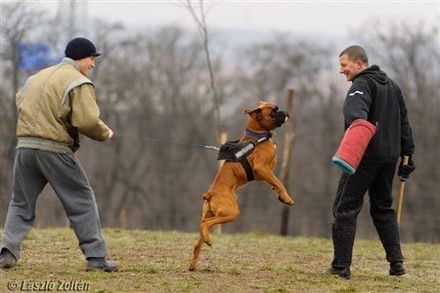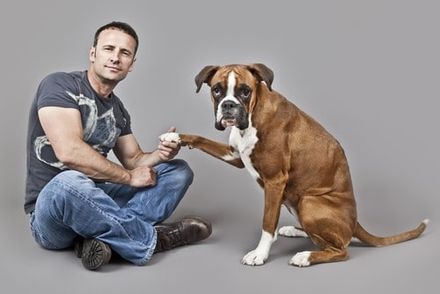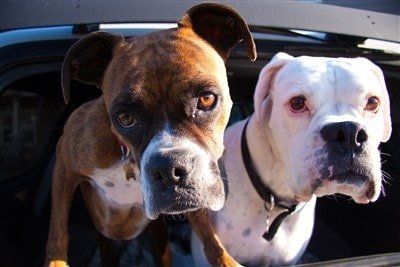The Boxer Dog Information Center
The Boxer is a medium to large breed developed in Germany. His ancestor is the now extinct Bullenbeisser, which was a large hunting dog in the Molosser group.
Accepted by the AKC in 1904, the Boxer was first extensively used as working dogs; most notably in the military.
Today, the Boxer is one of the most popular breeds, ranking consistently in the top 10 in the US. He is also a favorite canine companion in many European countries.
Found in fawn, brindle, and white (registrable but not standard), the Boxer has a short shiny coat and a moderate brachycephalic profile. In the US, ears may be cropped and tail may be docked; however natural ears and tail are becoming more common.
Friendly, great with kids and other dogs, smart, full of personality and high energy, the Boxer is an excellent canine family member.
Articles of Interest:
Boxer Dog Feeding Guidelines
- Updated
- Read the newest info regarding grain vs grain-free dog food (vital for this breed in particular) as well as newly updated recommendations.
Snacks, Chews, and Training Treats for a Boxer
- A helpful breakdown of the difference between these 3 things, how each should be used, and top recommendations for both puppies and adults.
Most Requested:
Boxer Dog Diarrhea
- Though this is never a fun subject, it's important to know what can cause this, immediate steps you should take from home, and red flags that warrant a vet visit.
Boxer Dog Dry Nose Issues
- Updated
- Be one step ahead of this common problem. How to prevent and heal dry noses. And, details about peeling, cracking, and crusting issues.
Boxer Dog has Hiccups
- Updated
- Reasons why hiccups happen and how to stop an episode.
How to Train a Boxer to Stop Jumping Up
- Boxers are super expressive, rather exuberant dogs, so it's common that a greeting involves jumping up onto you or your guests. Read exactly how to train your Boxer to remain calm and say hello in a more polite manner.
Boxer Dog Paw Care
- Everything you need to know, and things you didn't even know you were supposed to know about your Boxer's paws.
Popular Pages:
-min-280x205-384w.jpg)
From when you first get your new Boxer, through adulthood, and for his senior years, everything you need for optimal health, comfort, safety, and happiness.
Check out what you should have, why, and top recommendations.

Tamás Majoros is a professional dog trainer, living with his wife and son in Hungary. He specializes in bite protection work. He and his wife are also very active members of the Boxer rescue team of the NOE Animal Shelter Foundation.
See some really awesome photos of Tamás at work with a variety of Boxer dogs, and learn about his training methods and philosophy regarding training.
Grooming

With a short and sleek coat, shedding is kept to a minimum. Grooming involves many aspects including baths, brushings, nail trimming and dental care;which some owners underestimate as to how important it is to Boxer health.
Keeping your Boxer clean helps to keep your Boxer healthy. Learn the proper grooming
techniques for the Boxer dog.
Related:
Appearance
The Boxer dog is a medium breed dog, with a compact and powerful looking body. This breed has a short and shiny coat. In some, but not all regions of the world, the naturally long tail is docked
and/or the naturally moderate sized, thin ears are cropped.
The body is squared off, with a strong neck and the tail is set high.There is a certain bloodline of the Boxer dog which naturally has a very short tail called a bobtail.
The Boxer dog gets its unique look from a lower jaw that extends out past the upper jaw. The Boxer has deep dark brown eyes, a wide black nose and usually black facial markings on the muzzle, called a mask.
Folds are apparent on the face beginning at the base of the nose and carrying through to the sides of the muzzle.
Stat Information
Pronunciation:
Bauk-zer
Alternative Names:
German BoxerBreed Types: German, UK, American
Origin : Germany (Deutschland)
Date of Origin: The Boxer we know today: late 1800's
Family: Molosser
Group: AKC: Working, KC: Guardian FCI: Companion, Guard and Working Dog
Height, male Boxers : 23-25 inches (58.42-63.5 cm)
Height, female Boxers: 21.5-23.5 inches (54.6-59.7 cm)
Weight, males: 60-70 pounds (27-32 kg)
Weight, females: 55-65 pounds (25-29 kg)
Life Expectancy: 9-12 years
Purpose: Family dog, police dog, guide dog, therapy dog, herding dog
Average Litter Size: 6-8
Maturity Rate : Adulthood at 2 years
Purpose: Family dog, police dog, guide dog, therapy dog, herding dog
Average Litter Size: 6-8
Maturity Rate : Adulthood at 2 years
Be sure to check out:
Boxer Dog Care
- The top 10 most important tips for taking great care of your Boxer of any age. This is a great round-up and a good way to reassess the tasks and care you give to your Boxer dog.
Help Your Boxer Live a Long Life
- Take our quiz, see where you rank in regard to these vital elements that work together to extend life span for this breed.
Oldest Living Boxer Dogs
- Meet these documented teenage Boxer dogs. Great pics and profiles.
Color Overview
Recognized Standard Colors of the Boxer Dog:
- Fawn - Ranges in a variety of tones from light to dark
- Brindle - A two or more tone color pattern of striping
Recognized, Not Standard: White
Additional Color Markings, Standard:
- Black mask
- Black mask, white markings
- White markings
Markings, Not Standard:
- Brindle
- Fawn markings

These are the only colors of a purebred. This breed does not carry the DNA for a solid color black coat. For more detailed information regarding the colors of Boxers. See: Boxer Colors
Boxer Personality
The Boxer is known for being very active, happy and playful. The Boxer dog makes an ideal family pet, as this breed is known for its love of children and interaction with people. A quick learner and very intelligent, the Boxer performs wonderfully at dog agility shows and most owners do not find command or house training to be a big obstacle. This clever breed is often chosen to perform as guide dogs for the blind or as police dogs.
This breed has some very unusual, yet amusing behavior. For some insight on interesting Boxer issues, see our Articles section. We offer many sections on detailed Boxer dog behavior issues such Barking, problems with Chewing and Teething
and House Training. To learn more about how a Boxer will blend in with your family & what to expect, see the main Behavior
section.
Boxer Dog Health
Each breed of dog is more susceptible to certain diseases than other breeds. Keeping an eye out for the early symptoms of these health issues is a huge step toward a fast recovery and optimal reach of life span which is on average, 10-14 years. The most common possible health complications may be heart problems or thyroid issues.
Regular veterinarian checkups are vital; particularly after the age of 8. From that point on, the Boxer is the top breed to develop tumors. Early detection is vital. Learn about each disease that the Boxer is prone to, including cardiomyopathy arrhythmias, bloat and more. Learn how to keep your Boxer healthy with details of symptoms, diagnosis, prevention and treatment. See: Health
Feeding
A proper diet is vital to the health of your Boxer; in all stages of life: as a growing puppy, an active adult and a senior dog.
Each stage requires different feeding schedules.
We discuss the value of wet VS dry dog food, dangers of too much food at one time and other feeding issues to keep your pet Boxer healthy. For information on all that you need to know about feeding. See: Feeding
Puppies
We've got the info you are looking for. From newborns to learning all about caring for this breed during the long 2 year puppy phase.
Allergies
All dogs breeds can have allergies. According to the National Domestic Animal Statistical Information Center, just about 45% of dogs suffer from some type of allergy. These may be external or internal. If your Boxer dog has an allergy, this can manifest in many ways. The most common? Fur loss, itching, rashes, eye discharge, wheezing, coughing and diarrhea. Learn all of the signs of dog allergies & how you can help your Boxer. See:
Allergies
Female Boxers
If you have a female Boxer, you will want to know all about the female Boxer
Heat Cycle and the aspects of
pregnancy. The average sized litter of Boxers is 6 puppies. However, this can range from 2 to a whopping 10 or more! Taking care of a Boxer puppy is as rewarding as it is exhausting. We discuss detailed
puppy care to help your little Boxer dog grow into a happy and well adjusted adult dog. Once those puppies are born, learn the importance of socialization and how to keep your Boxer puppy happy.
Q&A
In the Boxer Dog Questions
section, you'll find some really interesting articles that cover all sorts of behavioral, care, grooming and health issues that owners find themselves needing to contend with.
AllBoxerInfo.com All content is protected by US and International copyright laws. All rights reserved.
We are a participant in the Amazon Services LLC
Associates Program, an affiliate advertising program designed to provide a means for us to earn fees by linking to Amazon.com and affiliated sites.
